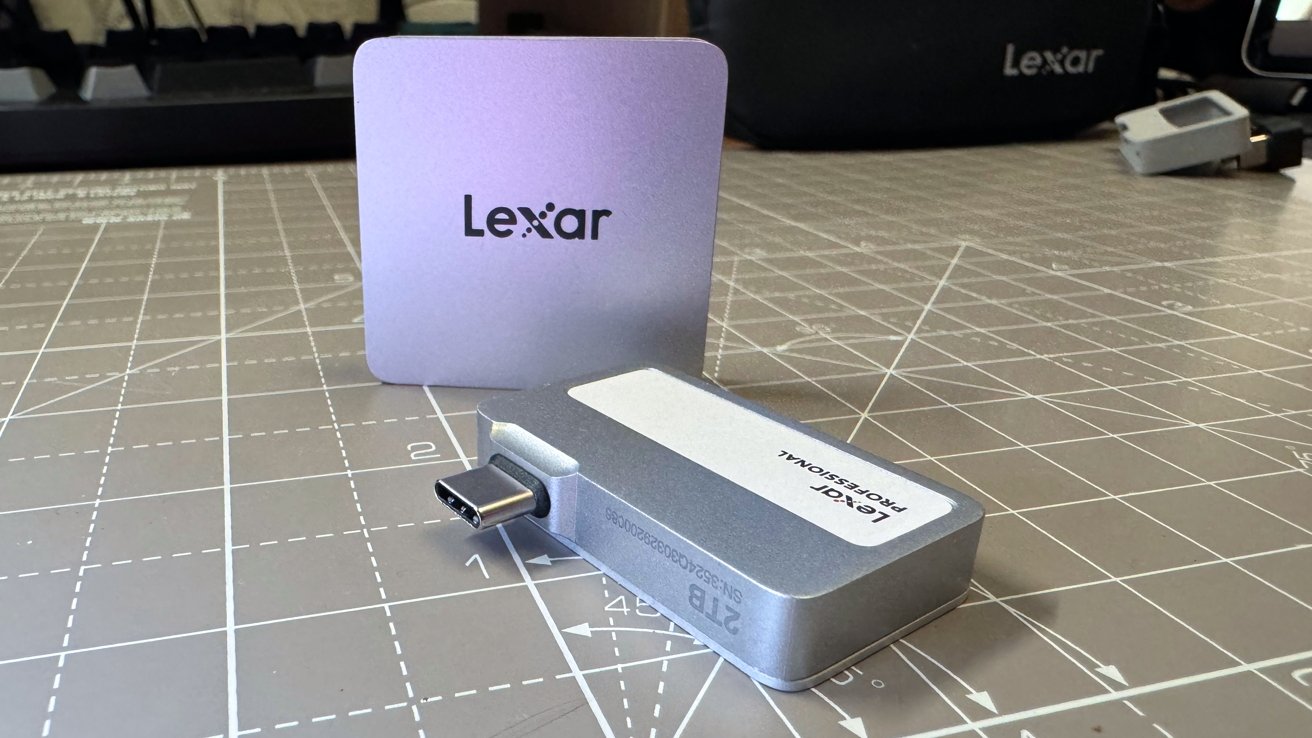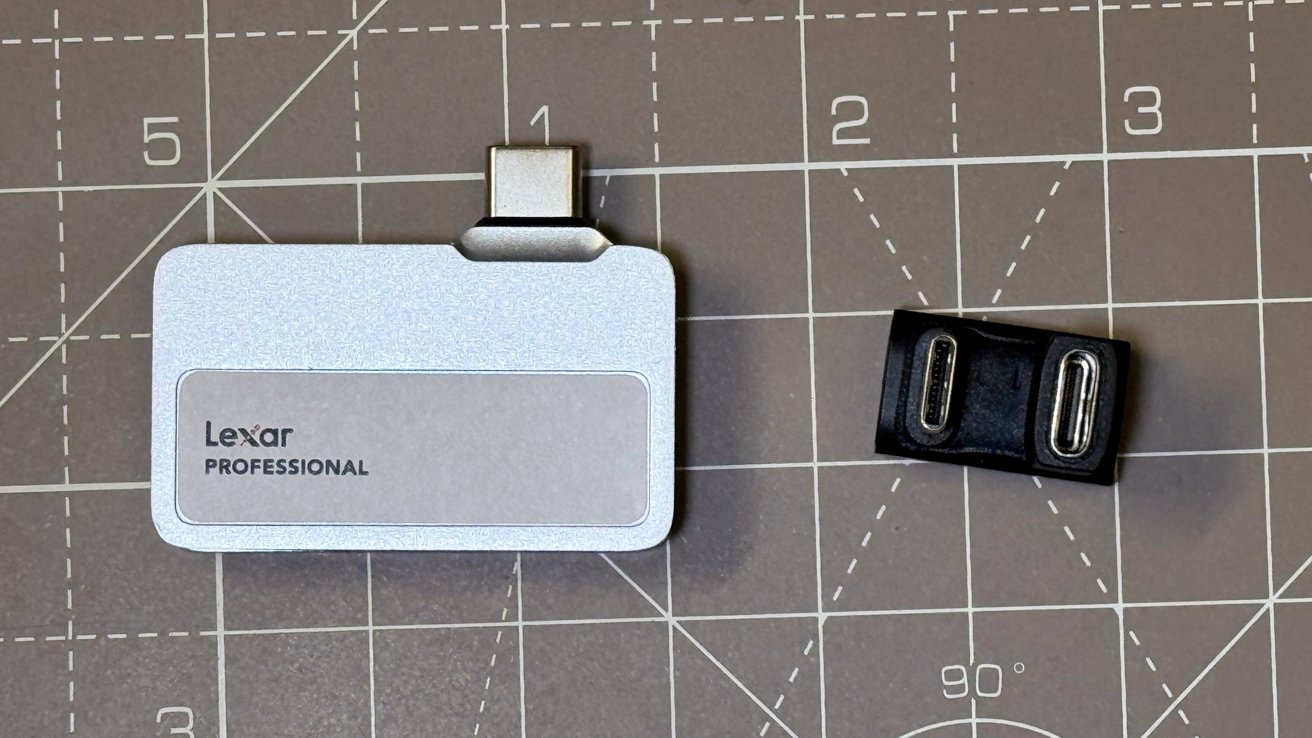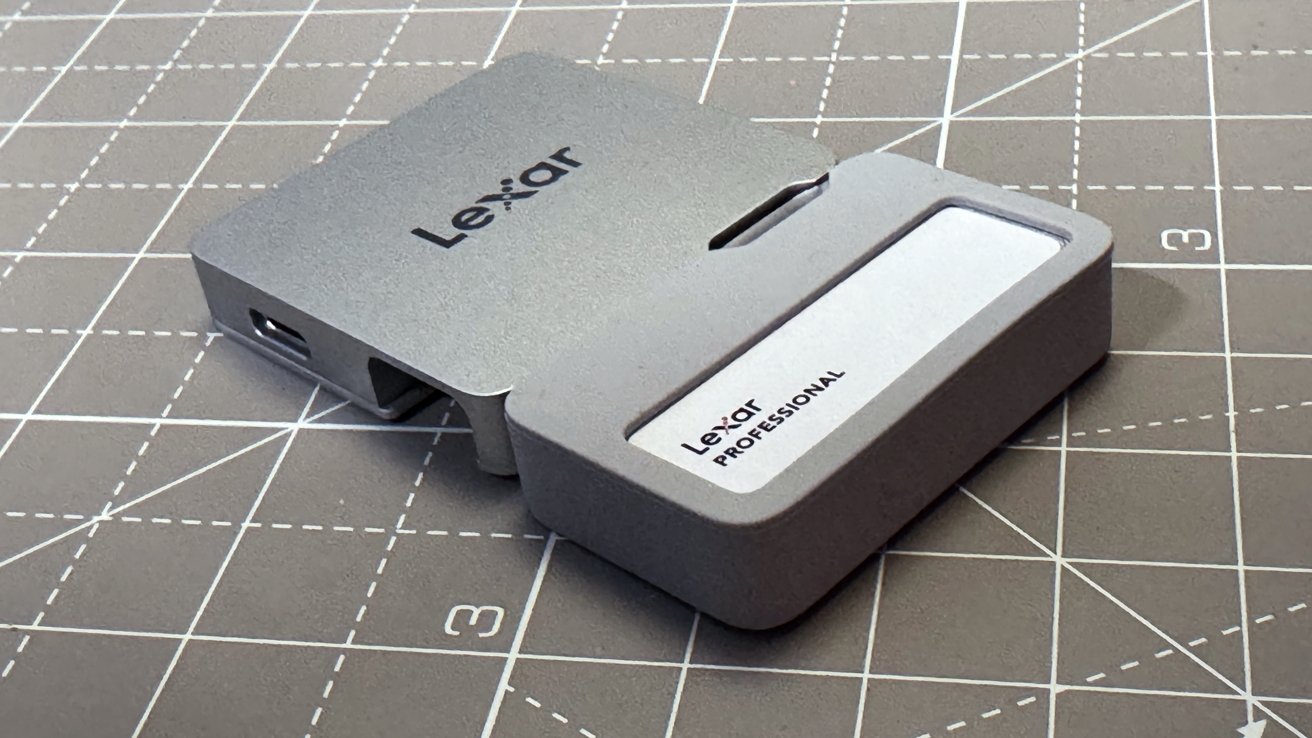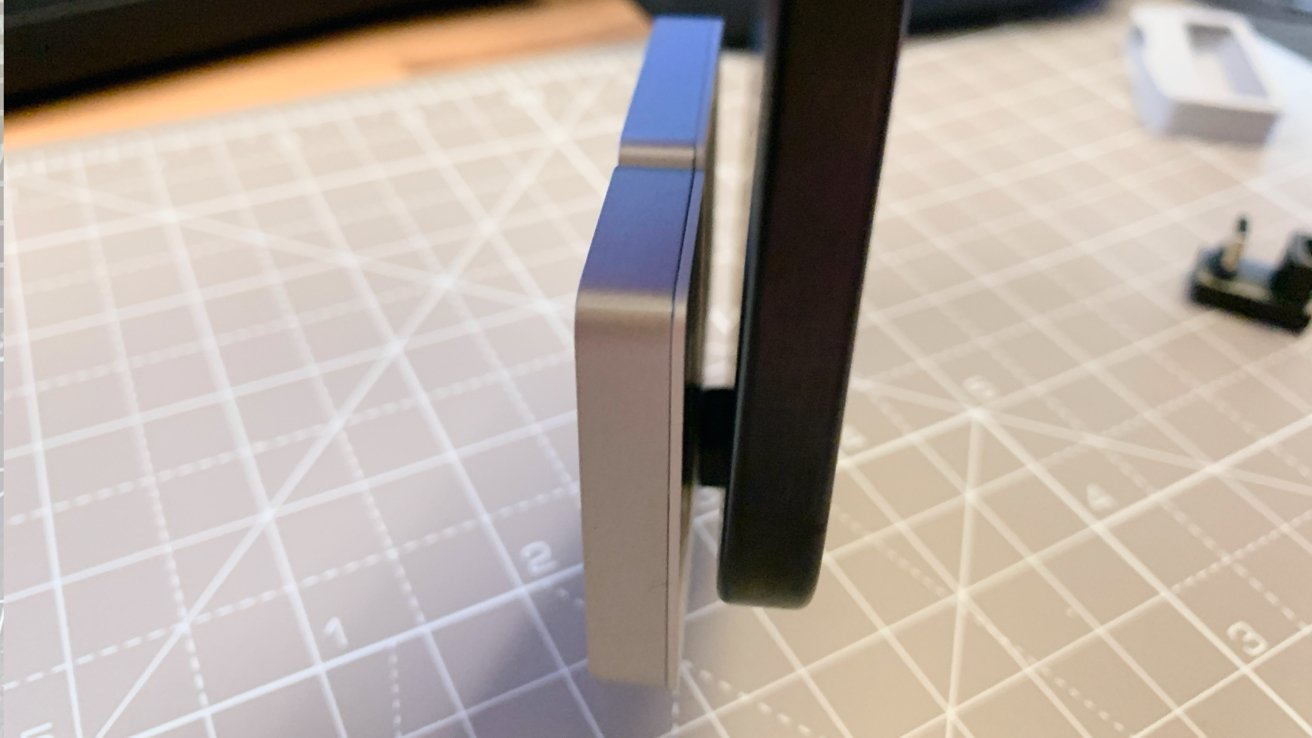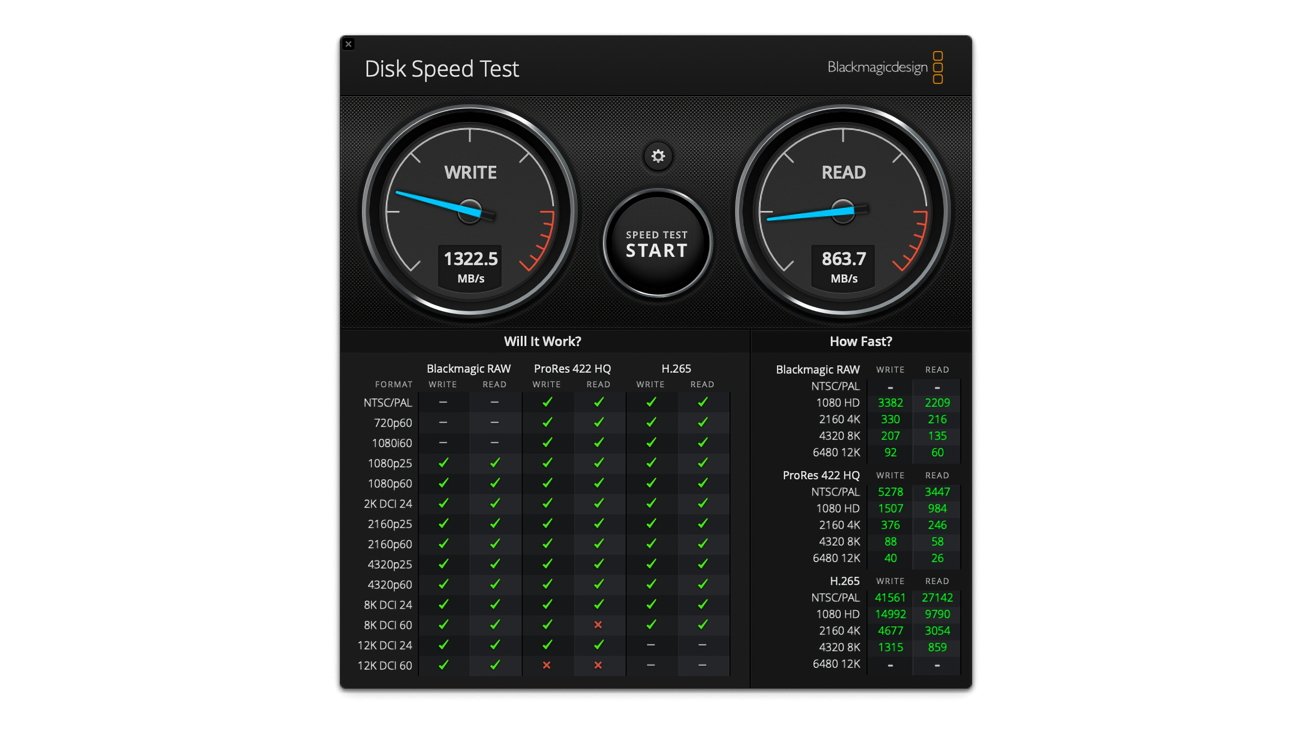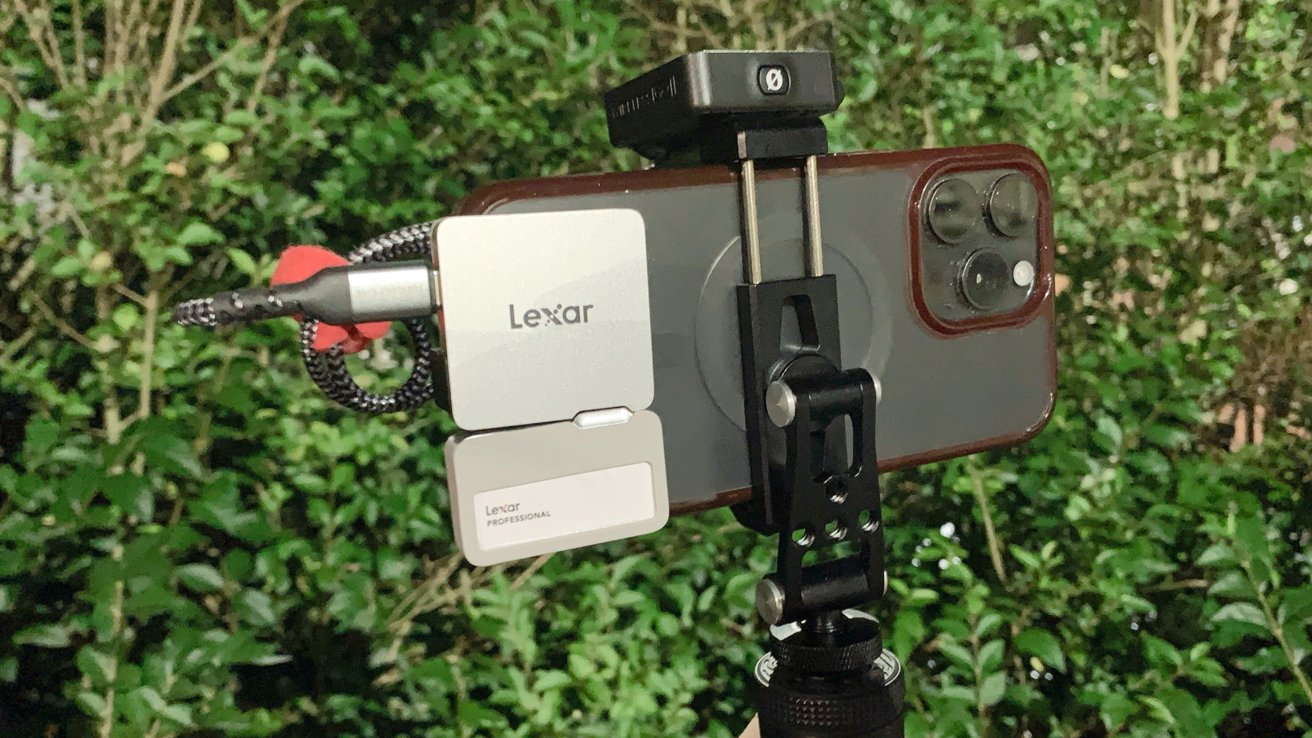The Lexar Professional Go Portable SSD with Hub could be the external recording solution that content creators have been looking for.
When Apple introduced the iPhone 15 Pro and Pro Max, it became possible for consumers and content creators to take advantage of external recording of video to USB-C. Under the right settings, you could record ProRes video to an external drive.
If you wanted 4K ProRes video at 60fpos, you had no choice but to use an external SSD for recording, as you couldn’t save it to the internal storage. For the iPhone 16 Pro, this is also true for 4K ProRes at 120fps.
The advent of USB-C also allowed other hardware to be hooked up, such as microphones or batteries, if you used a compatible hub. The problem, though, is that there hasn’t really been an elegant or compact way of using storage and a hub along with other hardware.
Lexar Professional Go Portable SSD with Hub review – The SSD
The meat of the package is the Professional Go Portable SSD itself. This extremely compact device is just 1.71 inches long, 0.98 inches wide, and 0.32 inches thick.
That width measurement is just for the main body, as there’s a USB-C plug sticking out of the side, making the width just shy of 1.4 inches.
It’s not a plug that moves either, so it doesn’t have the option to be hidden from view. But then again, at this size and using any of the supplied casings, it’s not a problem.
Lexar supplied a 2-terabyte version of the drive for review but also sells a 1TB model.
The casing is made partially from plastic with an aluminum backing. This helps make the already small drive extremely light at 0.46 ounces.
As a device aimed at being portable, it also has some built-in protectiveness, including IP65 dust and water resistance. The 1-meter (3-foot) drop resistance is also handy, as its size may make it easily droppable.
Further assisting its protectiveness is a thin silicone sleeve, which probably helps a bit with knocks and drops.
The protective box the drive is supplied in offers even more safety for the drive while also holding a little U-shaped connector and 20 sticker labels.
The connector is intended so that you can plug the drive and the iPhone into it, so that the drive can be mounted right behind your iPhone.
Lexar Professional Go Portable SSD with Hub review: The SSD fits on its own on the back of an iPhone.
You could plug the drive directly into an iPhone’s USB-C port, which will work fine. However, it will lengthen the overall assembled device, which may not be great for iPhone videography.
The U-shaped connector, in this case a male-to-female USB-C version, diverts the drive to behind the iPhone. For users, this makes sense as the drive is visually out of the way, and it’s much easier to hold on to the iPhone using your right hand.
Thanks to its compact size, you can very easily curl your fingers around it in this position.
If you were to use the connector without an iPhone case, the drive would be a few millimeters away from touching the back of the device. There is some leeway in the USB-C connector to allow it to be pressed against the back when holding the iPhone up, so there’s no real danger of disconnection or damage here.
That gap does allow you to use a case, though not one that’s too thick for the gap.
Lexar Professional Go Portable SSD with Hub review – The Hub
The Hub is the second part of the assembly, which makes a similar amount of sense. The point is that if you need to use a USB-C hub with an iPhone to plug many things in, you should make it as small as possible.
While not quite as tiny as the SSD, Lexar’s hub is still very small and impressive.
For a start, it’s an almost-square 1.69 by 1.71 inches, and a similar 0.32 inches deep. The design is such that, when used with the SSD, it can span most of the width of an iPhone 15 Pro Max’s rear panel without taking up much height or thickness.
Lexar didn’t make the hub as specifically durable as the SSD. It has a similar plastic-aluminum constriction, giving it a 1.27-ounce weight, but it doesn’t have the drop, dust, or water resistance.
The hub has four USB-C ports, starting with two in the base. One of the pair is sunk in, intended to be used with another U-shaped connector, this time male-to-male, to similarly wrap around the back of an iPhone.
As part of the design, Lexar made the U-connectors so they fit perfectly snugly one way around. This certainly helps make the hub stay put much more than you’d expect, given its placement.
To one side, there’s a USB-C port in a small divot, which is intended for the SSD to fit. The SSD has a small hump around the USB-C connector, which matches the hub’s divot while also helping to ensure it’s securely held.
Lexar Professional Go Portable SSD with Hub review: The hub and SSD do overhang the base of the iPhone.
The other side has a USB-C port with a power symbol next to it. While the other ports are designed to connect to devices for data purposes, this fourth port is meant to take in power from a source.
An adapter can help provide up to 30W of power delivery to a host device, such as a connected iPhone. If you have an iPhone camera rig, this would be where you would connect up a power bank for longer filming sessions.
All of the ports, including the one intended for power, use USB 3.2 Gen 2 and its 10Gbps of bandwidth.
With all of this in play, it might seem feasible to use it as a USB-C hub in its own right, if you have USB-C cables handy. Even though one port is sunk from the surface, you can still hook up USB-C cables to it if they’re not too chunky.
When hooked up to an iPhone or iPad, the hub works entirely as expected. You can connect more USB-C devices to it, like a microphone receiver, fine.
Don’t expect it to work like a proper hub for a Mac, though. It did work when connected to an M1 Mac mini, but it oddly ran slowly for bandwidth tests and didn’t allow a display to run through it either.
Obviously, it’s got an intended purpose, but it’s not necessarily an accessory that benefits your Mac.
In practice, the hub mounts around the back of the iPhone, similar to the SSD. It takes up more of the back than the SSD alone but can be mounted alongside it.
Lexar Professional Go Portable SSD with Hub review: WIthout a case, there’s a bit of a gap with the iPhone.
The gap is present again when used case-free, but it’s still not really a problem. Nor is it with a case, though again, you can’t use an iPhone case that’s too thick.
One small difference in holding the iPhone with both the Hub and SSD attached is that the U-connector’s use of the sunken USB-C port makes the hub overhang the base of the iPhone, whereas the SSD alone does not.
This overhang is about a third of an inch and isn’t really a nuisance here. What it does do is ensure that you can still fit a MagSafe charger on the rear or makes more room for the spine of whatever iPhone mount you decide to use.
It’s not difficult to carry the iPhone with the hub and SSD’s combined size, including the overhang.
Just ensure you’re holding onto the iPhone instead of gripping the hub and SSD. The latter two only hold onto the iPhone from a USB-C port.
As an aside, Lexar also includes a cold shoe adapter, effectively a USB-C cable that attaches to a cold shoe or hot shoe mounting point. This does give you more options for mounting the SSD or the hub to a filming rig, making it more useful in situations where it may not be practical to mount the hub behind the iPhone.
Lexar Professional Go Portable SSD with Hub review – Drive Performance
Lexar markets the SSD as running at up to 1,050MB/s for read speeds and up to 1,000MB/s for write speeds.
Connected to an M1 Mac mini directly and tested multiple times, we encountered far higher write speeds of 1,322.5MB/s. However, reads were lower at 863.7MB/s.
Lexar Professional Go Portable SSD with Hub review: Disk speed tests with Blackmagicdesign’s app on a Mac
These speeds are certainly usable enough for an external drive connected to a Mac, but they’re also a great sign for use on an iPhone.
Apple says that for external recording to an iPhone 15 Pro, Pro Max, or newer at 4K ProRes at 60fps, the drive has to support at least 220MB/s and a maximum power draw of 4.5W.
For 120fps on an iPhone 16 Pro, that figure doubles to 440MB/s.
It’s safe to say that, as recordable external storage, there’s more than enough headroom for the drive to comfortably take the recording.
While testing, we noticed that the SSD gets warm. This is to be expected for something so small under load, but it doesn’t seem too warm as to be dangerous.
Lexar Professional Go Portable SSD with Hub review – Not just for filming
While the Lexar Professional Go Portable SSD with Hub is obviously marketed to those who want to do more iPhone videography, it’s worth taking a moment to consider other applications for it.
For a start, it’s a massive drive that you can connect to your iPhone. Nothing stops you from storing other data on there, aside from having to deal with Apple’s Files app.
Indeed, Lexar includes software to use encryption, thinking of this scenario in advance. Connecting the SSD to a Mac gives you an installer that enables 256-bit AES encryption with the drive.
Of course, you don’t have to use it with an iPhone at all. You could just as easily attach it to an iPad Pro, both for storage and for connectivity.
Indeed, the small gap the U-connectors provide give enough wiggle room to attach the setup to an M2 iPad Pro and Magic Keyboard.
It’s certainly a videography tool, but there are plenty of areas where it can work beyond the iPhone.
An iPhone video dream
Videography on the iPhone is fairly simple, for the most part. The problems come in when you go to extremes, such as recording lots of video or needing high-fps ProRes footage in 4K.
As an external recorder for an iPhone, Lexar has come up with a really great solution. One that could directly connect or neatly hide on the rear.
Adding the hub element turns it into a very usable system for data storage and external recording, without losing out on other connections. Charging the iPhone and hooking up a USB-C mic receiver while also externally recording footage is a great combination for anyone serious about video.
With the exception of Mac-based usage, which is a stretch for its intended purpose, the Lexar Professional Go Portable SSD with Hub should be your first thought for recording footage.
It may be a bit of an investment, but it’s certainly worth it if you’re serious about the craft.
Lexar Professional Go Portable SSD with Hub review- pros
- Compact and data-dense
- Hub’s connectivity options
- System flexibility
Lexar Professional Go Portable SSD with Hub review- cons
- SSD warmth under sustained load
- Connectors can be a bit tight
- Hub isn’t great with Macs
Rating: 4.5 out of 5
Where to buy the Lexar Professional Go Portable SSD with Hub
The Lexar Professional Go Portable SSD with Hub is available to preorder from Amazon. The 1TB version costs $239. The 2TB version with hub is on B&H Photo for $349.99.
The SSD is also available on its own. The 1TB is priced at $189.99 on Amazon, with the 2TB at $299.99.
